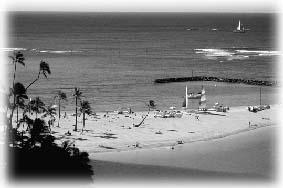|
First
There Was the Land
How
did the United States become such a big country? How
much do you know about the land? What are its geographic features?
Read the following text to get a clear picture of this vast
and beautiful land that has played an important role in American
history.
No
single force
has been responsible for shaping the background of American
history. But of the many that
have contributed, none played a more important role than the
land itself.
In the three centuries
needed to settle the continent, pioneer
marched toward the West in a never-ending procession. Whether
explorers, traders, farmers, or adventurers, the pioneers
all shared one thing in common.
They were drawn westward by the land, a land vast in size,
often free
for the taking, and
rich in undeveloped
natural resources.
Therefore, before beginning
the story of America's history, it is essential for us to
look at the background of the land itself. Since it is not
always possible for students of history to fly over the area
being studied, let us instead look at the map of the United
States.
First, we can divide the
continental United States into three basic areas: 1) the Atlantic
Seacoast west to the Appalachian Mountains; 2) the great
Mississippi River Basin between the Appalachian
and the Rocky Mountains; and 3) the Rockies west to the Pacific
Ocean.
The eastern one-third of
the United States may be further divided into three separate
areas: the Northeast and the South which are obviously different
from each other, and the area between them which has the characteristics
of both. The first major feature we can see on the map is
that the Appalachian Mountains do not run north to south but
northeast to southwest. Therefore, in the Northeast, the land
extending to the Atlantic coastline is mountainous and rocky.
In the deep South, there is a wide plain between the mountains
and the sea. In
the central area, there are plains on the coast which give way
rapidly to the foothills of the Appalachians and then to the
mountains themselves.
In the Northeast, rivers
flow only a relatively short distance from the mountains to
the ocean. As a result, they flow more rapidly than the rivers
in the South, which travel a longer way to the sea. The Northern
rivers are more useful as sources of water power than they
are as highways of commerce.
The land of the Northeast
is hilly and rocky. Much of it is still covered by heavy forests.
The coastline, however, is broken by many excellent harbors
which early in the history of the country became important
centers of commerce and trade. Off the coast and far into
the Atlantic Ocean, the warm waters of the Gulf Stream flowing north from Florida provide
a continuing supply of fish, adding to the resources of the
area.
In the deep South, the
more gently flowing rivers serve as highways of trade and
commerce. The rivers, plains, and mild temperatures of the
southeastern part of the United States make it suitable for
agriculture.
The middle area, with its
many rivers and flat coastal areas, combines the characteristics
of the North and the South and serves as a trade link between
them.
The whole eastern area
appears to be surrounded by the Appalachian Mountains. But,
since these mountains are very old and worn down, they have
never been a great barrier between the East and the central
Mississippi River Basin. Narrow gaps and wide valleys passing
through the Appalachians allow
to travel westward.
By far, the largest of
the three major sections of the United States is the area
between the Appalachians and the Rocky Mountains. Rivers rising in both mountain
chains flow toward each other down the sides of this vast
bowl, emptying into the Mississippi. Indians called this longest
of North American rivers "Father of Waters". Together
with the Missouri River, its chief western branch, the Mississippi
flows 4 000 miles (6 400 kilometers) from its sources in the
Rocky Mountains to the the Gulf of Mexico.
The rivers flowing west
from the Appalachians are fed not only by melting snow in
spring, but also by rain throughout the year. Sometimes in
the spring, more water pours into these rivers than their
banks can hold, leading to serious flooding. Flood control
projects have been necessary to bring this problem under control.
On the other hand, the
rivers that flow east toward the Mississippi find their main
source of water supply in the spring melting of snow from
the Rocky Mountains. Because the winds in the Far West blow
from the Pacific Ocean eastwards, clouds bearing
lose it as rain or snow on the western rather than the eastern
side of the Rockies. As a result, the clouds moving eastward
over the greater part of the Great Plains between
the Rockies and the Mississippi are dry. The area is mainly
watered only during the spring melting.
Although most of the central
basin of the United States is made up of dry, flat land, there
are two areas where the land is very rich. The area around
the Great Lakes is one of the most fertile in the nation.
Even though it is very hot in the summer and cold in the winter,
it is far better suited to agriculture than the Great Plains.
The Great Lakes themselves provide transportation, and plenty
of rainfall makes agriculture possible on a large scale. In
more recent times, this area's nearness to coal and iron resources
has helped it become one of the great industrial sections
of the United States. 
In the south, the soil
along the banks of the Mississippi is enriched by dirt
by rivers flooding the Great Plains in the spring. This wide
area is one of the richest agricultural regions in the United
States. It extends west of the Mississippi deep into Texas
and eastward almost to the Atlantic Ocean.
The huge Mississippi River
Basin is a source of great wealth to the United States in
both agriculture and industry.
The last of the three areas
into which the United States is usually divided is that between
the Rocky Mountains and the Pacific Ocean. Steep mountains
and high
still keep most of the area unpopulated. There are two fertile
sections however: the great northwestern valley where the
Columbia and Snake
Rivers meet and the Central Valley of California.
In the early history of
the United States, the Rockies were an almost impassable barrier
for settlers going to the Pacific Coast. The so-called "South
Pass" provided the only route to the rich
lands of the Northwest and California. Only far to the south,
where the mountains disappear, was there another way to California.
Although this area was dry, its natural resources made it
very valuable. In the nearby mountains, explorers discovered
many metals like gold, silver, and copper.
In California, the fertile
valleys and coastal plain produced great crops of fruit and
vegetables. Today, modern transportation has overcome the
barriers of desert and mountain, and the western area is of
great importance to the national economy.
Although geographically
separated from the other forty-eight states, Alaska and Hawaii
are both richly productive and add considerable wealth to
the nation. Alaska lies far to the north of the western United
States from which it is separated by the provinces of Canada.
It is very mountainous and cold much of the year. Although
in area it is the biggest state, Alaska has a very small population.
It is rich in natural resources, its economy depending largely
on fishing, oil, and timber.
Hawaii, however, is a tropical
area enjoying year-round sunny weather. The state is made
up of eight major islands of different sizes lying 2 000 miles
(3 218 kilometers) west of the California coast.
Plenty of
rainfall and fertile soil permit
a long growing season for
its main crops of pineapples and sugar cane. Because
it is in the mid-Pacific, Hawaii has always been a
for trade and commerce. With today’s rapid means of transportation,
tourism has also become a major industry. 
Since both Alaska and Hawaii
only became states in 1959, their histories are quite separate
from the mainstream of American development. Each, however,
has its own native culture and history.
This brief description
of American geography shows the country to be very fortunate.
The fact that it is, with the exception of Alaska, in the
climate zone is of basic importance. Another important feature
is the north-to-south direction of the mountain ranges. As
a result, almost all the rivers form navigation lines for
trade and commerce.
Nature has blessed North
America with rich natural resources. Except for the desert
areas centered around the southern Rockies, there are large
supplies of fresh water and numerous fertile valleys. Today
the rivers and streams of the United States
nearly two-thirds of the fresh water used daily by the cities
and for farm irrigation. They supply over 90 per cent of the
water used by industry, and almost all the water used to create
electric power.
Moreover, about one-third
of the land is forested. These wooded areas support a major
industry (forest products) and prevent the of soil that leads to flooding. In addition,
the nation produces millions of kilograms of iron each year
for its industries. Steel, the end product, is used in the
making of some 200 000 products. Of coal, a vital resource
for the steel, electric power, and chemical industries, there
are enough to last hundreds of years. Yet another basic industry
is petroleum, and America is one of the biggest producers
of oil in the world.
Of all the geographical
factors about America, however, the one which has played the
greatest role in the history of the United States has been
that of its physical isolation. The Atlantic and Pacific Oceans
have from the beginning given the nation the gift of time,
time in which to develop economically and politically.
Had the land been surrounded
by powerful enemies, the United States, whatever her resources,
would have had a far more difficult time developing according
to her own choices.
(1 646 words)
TOP
|
